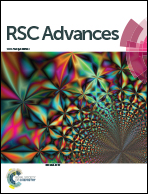Pillar[5]arene derivatives containing two dinitrophenyl rings: syntheses, conformations and the tubular self assembly in the solid state†
Abstract
Pillar[5]arene derivatives with two dinitrophenyl rings were synthesized in 90% and 99% yields. The di(2,4-dinitro-5-fluoro-phenyl)-modified pillar[5]arene self assembled into columns in the solid state.
![Graphical abstract: Pillar[5]arene derivatives containing two dinitrophenyl rings: syntheses, conformations and the tubular self assembly in the solid state](/en/Image/Get?imageInfo.ImageType=GA&imageInfo.ImageIdentifier.ManuscriptID=C5RA28117B&imageInfo.ImageIdentifier.Year=2016)

 Please wait while we load your content...
Please wait while we load your content...